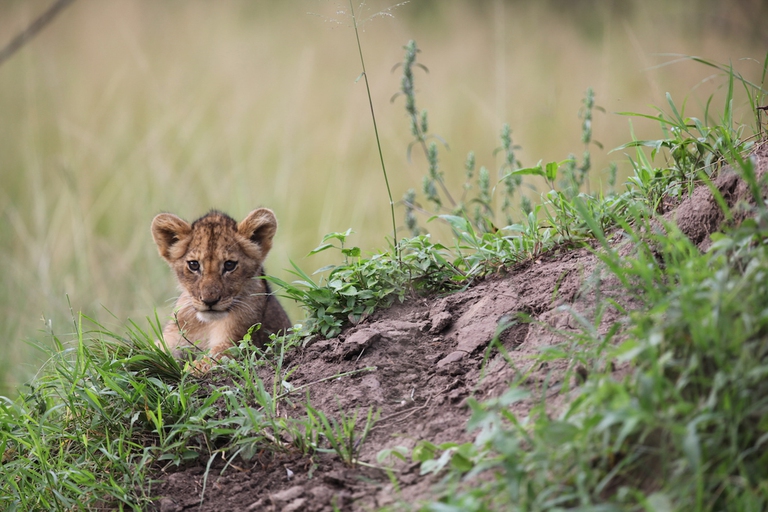
Our species took its first steps in a world covered in trees. Today, forests offer us sustenance, shelter, and clean the air that we breathe.
The first lions were finally born in Akagera National Park after close to two decades. African Parks and the Rwanda Development Board were pleased to confirm the news on the 12th of May. The park now counts ten lions, including the three cubs that were spotted one day earlier next to their mother, Shema. The
The first lions were finally born in Akagera National Park after close to two decades. African Parks and the Rwanda Development Board were pleased to confirm the news on the 12th of May. The park now counts ten lions, including the three cubs that were spotted one day earlier next to their mother, Shema.
The birth of the lion cubs is more evidence that the lions’ translocation to Rwanda in June 2015 and their integration into the park have been successful. It shows that the animals are relaxed and also healthy.
The South African lions bonded well in the boma, the enclosure they were kept in when they first arrived to the park, and their release went smoothly, says Sarah Hall, Akagera’s tourism and marketing manager. Incidents were only minor. “Shema was injured by a warthog but she recovered quickly without any intervention,” Hall explains. “Ntwari, the dominant male, we discovered has a bad eye, but we’ve consulted vets who believe it’s best to leave it than to intervene, especially since it doesn’t seem to be causing him any distress”.
Soon enough after their release, the females went to explore separately while the males stayed largely together, meeting the females within six weeks of release. “The males seem to now move between the different females, as though they’re checking up on them. They all seem to know exactly where each other is at any time,” adds Hall. Females have largely settled in specific areas while males just move between them.
Since the lions’ return, safari tourism in Akagera has increased by 23 per cent. The first lions were spotted a month after their release and sightings continue. “We didn’t expect it to happen so soon, as we thought they might avoid any human contact for a while following the translocation which is a stressful event”, Hall confesses.
But lions in Akagera seem to be very at ease near cars, especially Shema who has been seen the most. Being the oldest as well as having come from a well-visited park might explain why she feels so comfortable.
This groundbreaking conservation initiative was also necessary as a herbivore population control. Although the park isn’t overpopulated yet, together with the lions the herbivore population keeps growing with more births than deaths. “The lions have it easy at the moment. With few predators in the park, previously the sick and weak animals were surviving where elsewhere they would have been preyed upon long ago,” Hall explains. “Having lions also acts to strengthen the herbivore populations by weeding out the sick and weak animals”.
The community has expressed concern for the safety of their cattle but lions haven’t attempted to cross the fence and, in any case, they’re monitored closely with their collars. The community benefits from the growing tourism thanks, also, to their community tourism initiatives and revenue sharing scheme.
The lion cubs still rely on their mother for food and protection, but they’re not Shema’s first ones. It is hoped that she teaches her babies to be just like her. Mating has also been witnessed in the park which means that we should be expecting more cubs in the near future.
Siamo anche su WhatsApp. Segui il canale ufficiale LifeGate per restare aggiornata, aggiornato sulle ultime notizie e sulle nostre attività.
![]()
Quest'opera è distribuita con Licenza Creative Commons Attribuzione - Non commerciale - Non opere derivate 4.0 Internazionale.
Our species took its first steps in a world covered in trees. Today, forests offer us sustenance, shelter, and clean the air that we breathe.
Poachers in Africa are encroaching on wildlife land and killing rhinos in travel hot spots now devoid of visitors due to the coronavirus pandemic.
Actor and environmental activist Leonardo DiCaprio has contributed two million dollars to a fund to protect Virunga National Park in Congo from threats such as terrorism, the coronavirus and poaching.
For the first time in seventeen years, Iceland’s two main whaling companies won’t resume whale hunting. The announcement concerns this year’s season but could carry into the future.
The relationship between the coronavirus and wildlife is complex: while the pandemic may lead to a reduction in the illegal trade in wild animals, it may also encourage it in other respects.
The largest coral reef in the world is severely threatened by climate change, but researchers are developing strategies that could contribute to saving the Great Barrier Reef.
NGO Free the Bears has opened a mountain sanctuary for moon bears in Laos. With the government’s help, it aims to close all bile farms by 2022.
Seychelles have extended its marine protected area, which now covers over 400,000 square kilometres, an area larger than Germany.
The tapir was reintroduced into Brazil’s Atlantic Forest, the country’s most at-risk ecosystem. The species can play a key role in the forest’s recovery.











